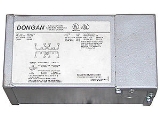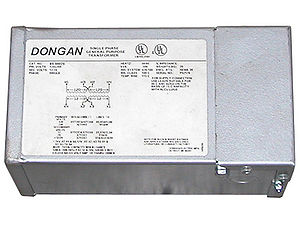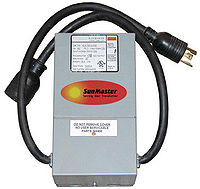
Buck-boost transformer
Encyclopedia

Transformer
A transformer is a device that transfers electrical energy from one circuit to another through inductively coupled conductors—the transformer's coils. A varying current in the first or primary winding creates a varying magnetic flux in the transformer's core and thus a varying magnetic field...
is a type of autotransformer
Autotransformer
An autotransformer is an electrical transformer with only one winding. The auto prefix refers to the single coil acting on itself rather than any automatic mechanism. In an autotransformer portions of the same winding act as both the primary and secondary. The winding has at least three taps where...
used to make small adjustments to the voltage applied to alternating current equipment. Buck–boost connections are used in several places such as uninterruptible power supply
Uninterruptible power supply
An uninterruptible power supply, also uninterruptible power source, UPS or battery/flywheel backup, is an electrical apparatus that provides emergency power to a load when the input power source, typically mains power, fails...
(UPS) units for computers, electric power distribution
Electric power distribution
File:Electricity grid simple- North America.svg|thumb|380px|right|Simplified diagram of AC electricity distribution from generation stations to consumers...
, and in the tanning bed industry. Operating electrical equipment at other than its designed voltage may result in poor performance, short operating life, or possibly overheating and damage.
For large adjustments in voltage (more than 15% to 20%), usually a two-winding transformer is used with the required voltage ratio, for example 240VAC to 120VAC. These transformers are more costly than buck–boost transformers since both windings must carry the full power delivered to the load, whereas the buck–boost winding must only carry a fraction of the load power.
Types
There are two basic types, self adjusting (active) or passive designs. The active types monitor incoming voltages and will adjust the outgoing voltage to be within an acceptable range. The system will either buck (lower) or boost (raise) the voltage if it senses a variance in the incoming voltage. Several taps are provided on the transformer winding which allow adjustment of the ratio. In an active buck–boost transformer, a control circuit selects which tap to use to maintain the output voltage within the desired range, over a range of input voltages. The control portion of the device that senses the voltage drop or rise is not technically part of the transformer, but rather a part of the larger transformer assembly.Passive transformers are used for larger equipment where the amount of buck or boost is fixed. For example, a fixed boost would be used when connecting equipment rated for 230 VAC to a 208 V power source.
The passive transformers are rated in volt-amperes (or more rarely, ampere
Ampere
The ampere , often shortened to amp, is the SI unit of electric current and is one of the seven SI base units. It is named after André-Marie Ampère , French mathematician and physicist, considered the father of electrodynamics...
s) and are rated for a percent of voltage drop or rise. For example, a buck–boost transformer rated at 10% rise at 208VAC will raise incoming voltage of 210VAC to 231VAC. A rating of 5% drop at 240VAC will yield the result of 233VAC if the actual incoming voltage is 245VAC.
Frequency
All transformers operate only with alternating current. Transformers change only voltage, not frequency. Equipment that uses induction motorsElectric motor
An electric motor converts electrical energy into mechanical energy.Most electric motors operate through the interaction of magnetic fields and current-carrying conductors to generate force...
will operate at a different speed if operated at other than the design frequency. Some equipment is marked on its nameplate to run at either 50 Hz or 60 Hz, and would need only the voltage adjusted with a buck–boost transformer.
Consumer and business applications

Fixed transformers with around the same cost were introduced primarily for the tanning market. They are prewired, and must be purchased with the exact amount of buck or boost needed for the application. They have factory-installed plugs and receptacles making installation very quick and easy, and reducing the need for hard-wiring small loads.
A typical fixed unit will have a NEMA
Néma
Néma is a town in southeastern Mauritania, close to the border with Mali. It is located at around . It is the capital of Hodh Ech Chargui Region and of the Néma Department....
6-20 plug for attachment to the prewired 240V wall receptacle, and a receptacle for the load equipment. This eliminates the need for professional installation if the exact incoming voltage can be determined. To make them easier for end-users to select, they are rated in load amps (A) rather than buck–boost volt-amps (kVA). These are used almost exclusively in light to moderate applications that require 40 amps or less.
Not all 240V equipment requires voltage correction. These transformers are used when electrical equipment has a voltage requirement that is slightly out of tolerance with the incoming power supply. This is most common when using 240V equipment in a business with 208V service or vice versa.
Equipment is typically labeled with its voltage rating, and may advertise the amount of tolerance it will accept before degraded performance or damage can be expected. A unit that requires 230VAC with a tolerance of 5% will not require a buck–boost transformer if the branch circuit (under load) is between 219VAC and 241VAC. Measurement should be made while the circuit is loaded, as the voltage can drop several volts compared to the open measurement. The transformer must be rated to carry the full load current or it will be damaged.
Electric power distribution applications
| Video clip of very large three-phase buck–boost transformers spread across utility poles (320x240, 180 kbps, 23 sec, no audio) – see also at 640x480 size, 600 kbps. |
Power traveling long distances in electric power grids can experience a condition known as voltage drop
Voltage drop
Voltage drop is the reduction in voltage in the passive elements of an electrical circuit. Voltage drops across conductors, contacts, connectors and source internal resistances are undesired as they reduce the supplied voltage while voltage drops across loads and other electrical and electronic...
due to the slight resistance of the metallic conductor having a cumulative effect over tens to hundreds of miles/kilometers. Distant customers may experience a drop of 5% to 10% of rated nominal line voltage.
To combat these effects, large boost transformers are placed on poles in remote locations to increase system voltage and bring the voltage back up to acceptable levels. The boosting consumes current capacity from the unboosted main line, reducing the main line current carrying capacity for all customers.
On three-phase power lines, the very large and heavy transformers are often spaced apart across three separate consecutive poles on the powerline, each boosting one of the three phases.

